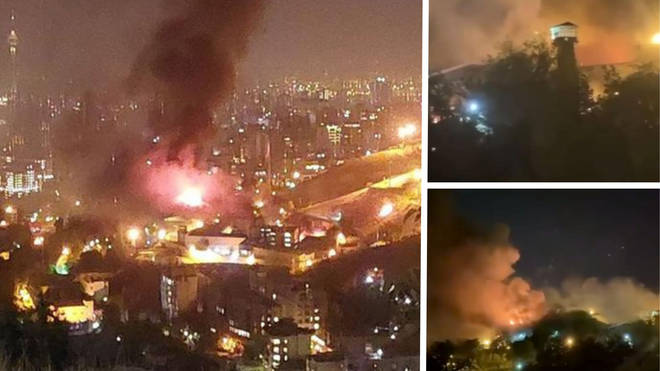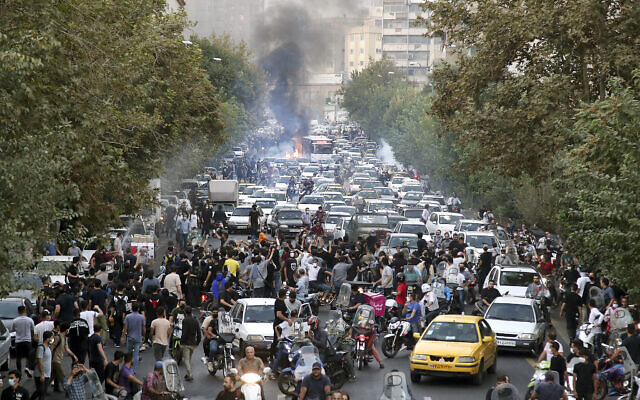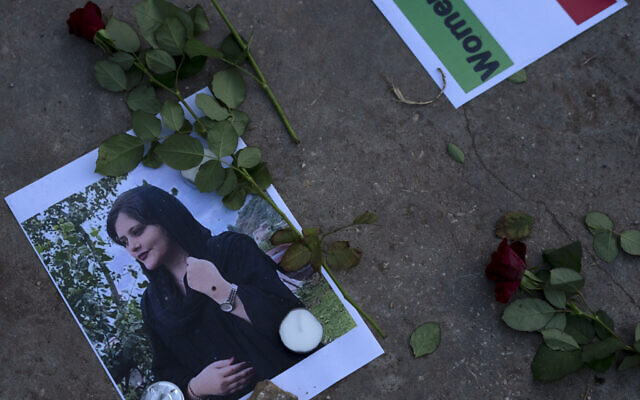Evin prison fire: explosions and gunshots reported in Iranian capital amid protests
15 October 2022

A large fire has broken out at Tehran's notorious Evin prison, where Iran's political prisoners and anti-government activists are kept.
The prison, which once housed British national Nazanin Zaghari-Ratcliffe, has become the latest location for unrest in Iran, as nationwide protests entered a fifth week.
It comes as state media blamed "criminal elements" for the blaze, with online videos and local media reporting the sound of gunshots.
The US-based Centre for Human Rights in Iran reported that an “armed conflict” broke out within the prison walls, saying shots were first heard in Ward 7 of the prison.
The prison fire occurred as protesters intensified anti-government demonstrations, sparked by the death of 22-year-old Mahsa Amini in September, along main streets and at universities in some cities across Iran on Saturday.
Read more:
Read more:
Witnesses said that police blocked roads to Evin prison, located in the north of the capital, and at least three major explosions were heard coming from the area.
Traffic was heavy along major motorways near the prison as the fire continued and drivers honked their horns to show their solidarity with the protests.
Shots continued to ring out as plumes of smoke engulfed the sky in Tehran amid the sound of an alarm, videos show.
Riot police could also be seen riding on motorbikes toward the facility, as were ambulances and fire trucks. Witnesses also reported that the internet was blocked in the area.
It comes anti-government monitoring group 1500tasvir posted videos of the fire online, with chants of "death to the dictator" - a primary slogan of the anti-government protest movement - heard echoing in the background.
It stands in contrast to Iran's official news agency IRNA, who said "the situation is currently completely under control".
Human rights monitors reported hundreds dead, including children, as the movement concluded its fourth week.
Demonstrators chanted “Down with the dictator” on the streets of Ardabil in the country’s north-west.
Outside of universities in Kermanshah, Rasht and Tehran, students rallied, according to videos on social media. In the city of Sanandaj, a hotspot for demonstrations in the northern Kurdish region, school girls chanted: “Woman, life, freedom” down a central street.
The protests erupted after public outrage over the death of Ms Amini in police custody. She was arrested by Iran’s morality police in Tehran for violating the Islamic Republic’s strict dress code.
Iran’s riot police caught on video sexually assaulting female protester during anti-hijab demo
15 October 2022

Video footage has emerged showing Iranian riot police sexually assaulting a female protester while trying to arrest her.
The footage has prompted a furious backlash on social media amid the month-long riots that have affected the country.
The footage, filmed at Argentina Square in Tehran on Wednesday shows a woman being detained and surrounded by riot police. One of them appears to grab her inappropriately from behind before she collapses to the ground. A female voice behind the camera can be heard saying: "They are pulling her hair."
She eventually manages to wrest herself free and run away.
Tehran's Police Public Relations office has said the incident is being investigated, state news agency Irna reported.
Iran has been rocked by a month of demonstrations driven by public outrage over Mahsa Amini's death on September 16 .
The country’s morality police had arrested her for an alleged breach of the Islamic republic's strict dress code for women.
The protests have drawn international support with US President Joe Biden saying: “'I want you to know that we stand with the citizens, the brave women of Iran.
“'It stunned me what it awakened in Iran. It awakened something that I don't think will be quieted for a long, long time,” he said.
“Women all over the world are being persecuted in various ways, but they should be able to wear in God's name what they want to wear,” said Biden.
Iran “has to end the violence against its own citizens simply exercising their fundamental rights,” he added.
At least 108 people have been killed in the Amini protests, and at least 93 more have died in separate clashes in Zahedan, according to human rights groups.
Iran death toll climbs to 233, rights group says, as protests enter fifth week
By SAMYA KULLAB

Protesters chant slogans during a protest over the death of a woman who was detained by the morality police, in downtown Tehran, Iran, September 21, 2022. (AP Photo, File)
BAGHDAD (AP) — Protesters intensified anti-government demonstrations along main streets and at universities in some cities across Iran on Saturday. Human rights monitors reported hundreds have died, including children, as the movement entered its fifth week.
Demonstrators chanted “Down with the Dictator” on the streets of Ardabil in the country’s northwest. Outside of universities in Kermanshah, Rasht and Tehran, students rallied, according to videos on social media. In the city of Sanandaj, a hotspot for demonstrations in the northern Kurdish region, school girls chanted, “Woman, life, freedom,” down a central street.
The protests erupted after public outrage over the death of 22-year-old Mahsa Amini in police custody
She was arrested by Iran’s morality police in Tehran for violating the Islamic Republic’s strict dress code. Iran’s government insists Amini was not mistreated in police custody, but her family says her body showed bruises and other signs of beating after she was detained.
At least 233 protesters have been killed since demonstrations swept Iran on September 17, according to US-based rights monitor HRANA. The group said 32 of the dead were below the age of 18. Earlier, Oslo-based Iran Human Rights estimated 201 people have been killed.
Iranian authorities have dismissed the unrest as a purported Western plot, without providing evidence.

A photo depicting Mahsa Amini, a young Iranian woman who died after being arrested in Tehran by Iran’s notorious so-called ‘morality police,’ seen during a protest by Israeli women in solidarity with Iranian women in central Jerusalem, Thursday, October 6, 2022. (AP Photo/ Maya Alleruzzo)
Public anger in Iran has coalesced around Amini’s death, prompting girls and women to remove their mandatory headscarves on the street in a show of solidarity.
Other segments of society, including oil workers, have also joined the movement, which has spread to at least 19 cities, becoming one of the greatest challenges to Iran’s theocracy since the country’s 2009 Green Movement.
Commercial strikes resumed Saturday in key cities across the Kurdish region, including Saqqez, Amini’s hometown and the birthplace of the protests, Bukan and Sanandaj.
The government has responded with a brutal crackdown, arresting activists and protest organizers, reprimanding Iranian celebrities for voicing support, even confiscating their passports, and using live ammunition, tear gas and sound bombs to disperse crowds, leading to deaths.
In a video widely distributed Saturday, plainclothes Basij, a paramilitary volunteer group, are seen forcing a woman into a car and firing bullets into the air amid a protest in Gohardasht, in northern Iran.
Widespread internet outages have also made it difficult for protesters to communicate with the outside world, while Iranian authorities have detained at least 40 journalists since the unrest began, according to the Committee to Protect Journalists.
by Reuters and Algemeiner Staff
OCTOBER 15, 2022

A police motorcycle burns during a protest over the death of Mahsa Amini, a woman who died after being arrested by the Islamic republic’s “morality police,” in Tehran, Iran, September 19, 2022. Photo: WANA (West Asia News Agency) via REUTERS
Protesters across Iran defied a nearly month-long crackdown on Saturday, activists said, chanting in the streets and in universities against the country’s clerical leaders in a sustained wave of anger at the death of Mahsa Amini.
The protests sweeping Iran since Amini – a 22-year-old woman from the country’s Kurdish region – died on Sept. 16 while being held for “inappropriate attire” pose one of the most serious challenges to the Islamic Republic since the 1979 revolution.
Although the unrest does not appear close to toppling the system, the protests have widened into strikes that have closed shops and businesses, touched the vital energy sector and inspired brazen acts of dissent against Iran’s religious rule.
A video posted by the Norway-based organization Iran Human Rights purported to show protests in the northeastern city of Mashhad, Iran’s second most populous city, with demonstrators chanting “Clerics get lost” and drivers honking their horns.
Videos posted by the group showed a strike by shopkeepers in the northwestern Kurdish city of Saqez – Amini’s home town – and female high school students chanting “Woman, Life, Freedom” on the streets of Sanandaj, the capital of Kurdistan province.
Protests were also reported in Isfahan, in central Iran, and in the southeast of the country.
Reuters could not independently verify the videos. Phone and internet services in Iran have been frequently disrupted over the last month and internet watchdog NetBlocks reported “a new major disruption” shortly before Saturday’s protests began.
Amini died in custody after she was detained by morality police for violating strict religious regulations requiring women to be modestly dressed.
TEENAGE GIRL DIES
Human rights groups say more than 200 people have been killed in the crackdown nationwide, including teenage girls whose deaths have become a rallying cry for more demonstrations demanding the downfall of the Islamic Republic.
Protesters called on Saturday for demonstrations in the northwestern city of Ardabil over the death of Asra Panahi, a teenage girl from the Azeri ethnic minority who activists say was beaten to death by security forces.
Officials denied the report and news agencies close to the Revolutionary Guards quoted her uncle as saying the high school student had died of a heart problem.
Videos posted on social media by activist website 1500tasvir purported to show street protests in Ardabil, while another social media video showed riot police retreating from rock-throwing demonstrators.
Iran has blamed the violence on enemies at home and abroad, including armed separatists and Western powers, accusing them of conspiring against the Islamic Republic and denying that security forces have killed protesters.
In his toughest warning yet to protesters, Supreme Leader Ayatollah Ali Khamenei – whose downfall many demonstrators have demanded – said on Friday that no one should dare think they can uproot the Islamic Republic.
State TV has reported at least 26 members of the security forces have been killed. The Tehran commander of the Basij militia forces that have deployed against protesters said in Tehran that three Basij had been killed and 850 more injured.
Hasan Hasanzadeh told the state news agency IRNA there were 380 Basij battalions in Tehran, without giving exact numbers.
In Tehran’s Shariaty technical college, female students chanted slogans against the four decade-long clerical rule. “So many years of crimes, death to this religious leadership,” they chanted, according to a video posted on social media.
Iran’s foreign minister spoke on Friday with the European Union’s top diplomat Josep Borrell, who urged Tehran to stop the repression of protesters.
In a phone call, Hossein Amirabdollahian told Borrell Iran allowed peaceful protests and its government enjoyed popular support, state media said. “Therefore, we recommend that Europeans look at the issue with a realistic approach,” he said.
New EU sanctions on some 15 Iranians are expected to be approved on Monday, diplomats said. Asset freezes and travel bans will have little concrete impact on the individuals, but diplomats said it sent a political message and showed growing international concern about the crackdown.





